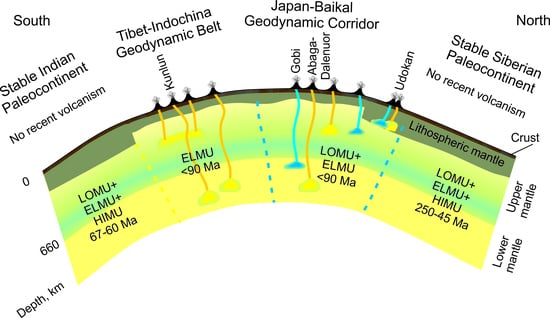Mantle Evolution of Asia Inferred from Pb Isotopic Signatures of Sources for Late Phanerozoic Volcanic Rocks
Abstract
1. Introduction
1.1. Backgrounds
1.2. Isotopic Age Assessments of Mantle Sources for Volcanic Rocks
1.3. Previous Interpretations of Isotopic Data
1.4. Strategy for Analysis of Pb Isotope Data
2. Results
2.1. Age Sequence of Protoliths in Mantle Sources
2.2. Hadean (4.51–4.44 Ga)
2.3. Early Archean (4.0–3.6 Ga)
2.4. Paleoproterozoic (2.0–1.8 Ga)
2.5. Neoproterozoic (0.7–0.6 Ga)
2.6. Late Phanerozoic (<0.25 Ga)
2.7. Indefinite Ages
3. Discussion
3.1. Age Comparisons of the Viscous Protomantle with Hadean Detrital Zircons and Protoliths
3.2. Generation of the Viscous Protomantle
3.3. Sources of the Oldest Lithosphere and Lower Mantle
3.4. Age Systematics of Mantle Sources
3.5. Permanent versus Changing Common Components
3.6. LOMU–ELMU versus HIMU Components in the Global Geodynamic Context
4. Conclusions
Author Contributions
Funding
Acknowledgments
Conflicts of Interest
References
- Castillo, P. The Dupal anomaly as a trace of the upwelling lower mantle. Nature 1988, 336, 667–670. [Google Scholar] [CrossRef]
- Gu, Y.J.; Dziewonski, A.; Weijia, S. Models of the mantle shear velocity and discontinuities in the pattern of lateral heterogeneities. J. Geophys. Res. 2001, 106, 11169–11199. [Google Scholar] [CrossRef]
- Hart, S.R. A large-scale isotope anomaly in the Southern Hemisphere mantle. Nature 1984, 309, 753–757. [Google Scholar] [CrossRef]
- Rasskazov, S.V.; Bowring, S.A.; Housh, T.; Demonterova, E.I.; Logatchev, N.A.; Ivanov, A.V.; Saranina, E.V.; Maslovskaya, M.N. Isotopic systematics of Pb, Nd and Sr in the heterogeneous continental lithosphere over the region of the convecting mantle. Doklady Earth Sci. 2002, 387, 519–523. [Google Scholar]
- Jackson, M.G.; Becker, T.W.; Konter, J.G. Evidence for a deep mantle source for EM and HIMU domains from integrated geochemical and geophysical constraints. Earth Planet. Sci. Lett. 2018, 484, 154–167. [Google Scholar] [CrossRef]
- Homrighausen, S.; Hoernle, K.; Hauff, F.; Geldmacher, J.; Wartho, J.-A.; Van Den Bogaard, P.; Garbe-Schönberg, D. Global distribution of the HIMU end member: Formation through Archean plume-lid tectonics. Earth Sci. Rev. 2018, 182, 85–101. [Google Scholar] [CrossRef]
- Tatsumi, Y.; Maruyama, S.; Nohda, S. Mechanism of backarc opening in the Japan Sea: Role of asthenospheric injection. Tectonophysics 1990, 181, 299–306. [Google Scholar] [CrossRef]
- Zonenshain, L.P.; Kuzmin, M.I.; Bocharova, N.Y. Hot field tectonics. Tectonophysics 1991, 199, 165–192. [Google Scholar] [CrossRef]
- Courtillot, V.; Davaille, A.; Bess, J.; Stock, J. Three distinct types of hotspots in the Earth’s mantle. Earth Planet. Sci. Lett. 2003, 205, 295–308. [Google Scholar] [CrossRef]
- Maruyama, S.; Santosh, M.; Zhao, D. Superplume, supercontinent, and postperovskite: Mantle dynamics and anti-plate tectonics on the core–mantle boundary. Gondwana Res. 2007, 11, 7–37. [Google Scholar] [CrossRef]
- Hart, S.R.; Gerlach, D.C.; White, W.M. A possible new Sr–Nd–Pb mantle array and consequence for mantle mixing. Geochim. Cosmochim. Acta 1986, 50, 1551–1557. [Google Scholar] [CrossRef]
- Staudigel, H.; Park, K.; Pringle, M.; Rubenstone, J.; Smith, W.; Zindler, A. The longevity of the South Pacific isotopic and thermal anomaly. Earth Planet. Sci. Lett. 1991, 102, 24–44. [Google Scholar] [CrossRef]
- Zindler, A.; Hart, S.R. Chemical geodynamics. Annu. Rev. Earth Planet. Sci. 1986, 14, 493–571. [Google Scholar] [CrossRef]
- Rasskazov, S.V.; Chuvashova, I.S.; Yasnygina, T.A.; Sun, Y.-M.; Saranina, E.V. General Pb-isotopic systematics of sources of volcanic rocks of the latest stage of Asia. Geodyn. Tectonophys. 2019, 10, 507–539. [Google Scholar] [CrossRef]
- Hofmann, A.W.; White, W.M. Mantle plumes from ancient oceanic crust. Earth Planet. Sci. Lett. 1982, 57, 421–436. [Google Scholar] [CrossRef]
- Hauri, E.H.; Whitehead, J.A.; Hart, S.R. Fluid dynamic and geochemical aspects of entrainment in mantle plumes. J. Geophys. Res. 1994, 99, 24275–24300. [Google Scholar] [CrossRef]
- Murphy, D.T.; Kamber, B.S.; Collerson, K.D. A refined solution to the first terrestrial Pb-paradox. J. Petrol. 2003, 44, 39–53. [Google Scholar] [CrossRef]
- Hart, S.R.; Gaetani, G.A. Mantle Pb paradoxes: The sulfide solution. Contrib. Mineral. Petrol. 2006, 152, 295–308. [Google Scholar] [CrossRef]
- Bertranda, H.; Chazotb, G.; Blichert-Toft, J.; Thorala, S. Implications of widespread high-μ volcanism on the Arabian Plate for Afar mantle plume and lithosphere composition. Chem. Geol. 2003, 198, 47–61. [Google Scholar] [CrossRef]
- Granet, M.; Wilson, M.; Achauer, U. Imaging a mantle plume beneath the French Massif Central. Earth Planet. Sci. Lett. 1995, 136, 281–296. [Google Scholar] [CrossRef]
- Lustrino, M.; Wilson, M. The circum-Mediterranean anorogenic Cenozoic igneous province. Earth Sci. Rev. 2007, 81, 1–65. [Google Scholar] [CrossRef]
- Allègre, C.J. Isotope Geology, 2nd ed.; Cambridge University Press: Cambridge, UK, 2008. [Google Scholar]
- White, W.M. Probing the Earth’s deep interior through geochemistry. Geochem. Perspect. 2015, 4, 95–96. [Google Scholar] [CrossRef]
- Menzies, M.A. (Ed.) Continental Mantle; Clarendon Press: Oxford, UK, 1990. [Google Scholar]
- Kreemer, C.; Holt, W.E.; Haines, A.J. An integrated global model of present-day plate motions and plate boundary deformation. Geophys. J. Int. 2003, 154, 8–34. [Google Scholar] [CrossRef]
- Molnar, P.; Tapponier, P. Cenozoic tectonics of Asia: Effects of a continental collision. Science 1975, 189, 419–426. [Google Scholar] [CrossRef] [PubMed]
- Sengör, A.M.; Natal’in, B.A. Paleotectonics of Asia: Fragments of a synthesis. In The Tectonic Evolution of Asia; Yin, A., Harrison, M., Eds.; Cambridge University Press: Cambridge, UK, 1996; Volume 21, pp. 486–640. [Google Scholar]
- Tapponier, P.; Peltzer, G.; Dain, A.L.; Armijo, R.; Cobbold, P.R. Propagating extrusion tectonics in Asia: New insights from simple experiments with plasticine. Geology 1982, 10, 611–616. [Google Scholar] [CrossRef]
- Yoshida, M. Preliminary three-dimensional model of mantle convection with deformable, mobile continental lithosphere. Earth Planet. Sci. Lett. 2010, 295, 205–218. [Google Scholar] [CrossRef]
- Yoshida, M.; Santosh, M. Supercontinents, mantle dynamics and plate tectonics: A perspective based on conceptual vs. numerical models. Earth Sci. Rev. 2011, 105, 1–24. [Google Scholar] [CrossRef]
- Zatman, S.A.; Gordon, R.G.; Mutnuri, K. Dynamics of diffuse oceanic plate boundaries: Insensitivity to rheology. Geophys. J. Int. 2005, 162, 239–248. [Google Scholar] [CrossRef]
- Beck, R.A.; Burbank, D.W.; Sercombe, W.J.; Riley, G.W.; Barndt, J.K.; Berry, J.R.; Afzal, J.; Khan, A.M.; Jurgen, H.; Metje, J.; et al. Stratigraphic evidence for an early collision between northwest India and Asia. Nature 1995, 373, 55–58. [Google Scholar] [CrossRef]
- Khan, S.D.; Stern, R.J.; Manton, M.I.; Copeland, P.; Kimura, J.I.; Khan, M.A. Age, geochemical and Sr–Nd–Pb isotopic constraints for mantle source characteristics and petrogenesis of Teru volcanics, Northern Kohistan terrane, Pakistan. Tectonophysics 2004, 393, 263–280. [Google Scholar] [CrossRef]
- Tappe, S.; Smart, K.; Torsvik, T.; Massuyeau, M.; De Wit, M. Geodynamics of kimberlites on a cooling Earth: Clues to plate tectonic evolution and deep volatile cycles. Earth Planet. Sci. Lett. 2018, 484, 1–14. [Google Scholar] [CrossRef]
- Albarède, F. Volatile accretion history of the terrestrial planets and dynamic implications. Nature 2009, 461, 1227–1233. [Google Scholar] [CrossRef] [PubMed]
- Allègre, C.J.; Dupré, B.; Brévart, O. Chemical aspects of the formation of the core. Philos. Trans. R. Soc. Lond. 1982, 306, 49–59. [Google Scholar]
- Wood, B.J.; Halliday, A.N. The lead isotopic age of the Earth can be explained by core formation alone. Nature 2010, 465, 767–770. [Google Scholar] [CrossRef]
- Harris, N.R. Isotopic, Geochemical, and Geochronological Constraints on the Origin and Evolution of Cenozoic Volcanism, Baikal Rift Zone, Siberia. Ph.D. Dissertation, Massachusetts Institute of Technology, Cambridge, MA, USA, 1998. [Google Scholar]
- Rasskazov, S.V.; Brandt, S.B.; Brandt, I.S. Radiogenic Isotopes in Geologic Processes; Springer: Berlin/Heidelberg, Germany, 2010. [Google Scholar]
- Rasskazov, S.; Sun, Y.-M.; Chuvashova, I.; Yasnygina, T.; Yang, C.; Xie, Z.; Saranina, E.; Gerasimov, N.; Vladimirova, T. Trace-element and Pb isotope evidence on extracting sulfides from potassic melts beneath Longmenshan and Molabushan volcanoes, Wudalianchi, Northeast China. Minerals 2020, 10, 319. [Google Scholar] [CrossRef]
- Chandrasekharam, D.; Mahoney, J.J.; Sheth, H.C.; Duncan, R.A. Elemental and Nd-Sr-Pb isotope geochemistry of flows and dikes from the Tapi rift, Deccan flood basalt province, India. J. Volcanol. Geotherm. Res. 1999, 93, 111–123. [Google Scholar] [CrossRef]
- Chen, Y.; Zhang, Y.; Graham, D.; Su, S.; Deng, J. Geochemistry of Cenozoic basalts and mantle xenoliths in Northeast China. Lithos 2007, 96, 108–126. [Google Scholar] [CrossRef]
- Choi, S.H.; Mukasa, S.B.; Kwon, S.-T.; Andronikov, A.V. Sr, Nd, Pb and Hf isotopic compositions of late Cenozoic alkali basalts in South Korea: Evidence for mixing between the two dominant asthenospheric mantle domains beneath East Asia. Chem. Geol. 2006, 232, 134–151. [Google Scholar] [CrossRef]
- Kuritani, T.; Kimura, J.-I.; Ohtani, E.; Miyamoto, H.; Furuyama, K. Transition zone origin of potassic basalts from Wudalianchi volcano, northeast China. Lithos 2013, 156, 1–12. [Google Scholar] [CrossRef]
- Melluso, L.; Mahoney, J.J.; Dallai, L. Mantle sources and crustal input as recorded in high-Mg Deccan Traps basalts of Gujarat (India). Lithos 2006, 89, 259–274. [Google Scholar] [CrossRef]
- Park, K.-H.; Park, J.-B.; Cheong, C.-S.; Oh, C.W. Sr, Nd and Pb isotopic systematics of the Cenozoic basalts of the Korean Peninsula and their implications for the Permo-Triassic continental collision boundary. Gondwana Res. 2005, 8, 529–538. [Google Scholar] [CrossRef]
- Peng, Z.X.; Mahoney, J.J.; Hooper, P.R.; Harris, C.; Beane, J.E. A role for lower continental crust in flood basalt genesis? Isotopic and incompatible element study of the lower six formations of the Western Deccan Traps. Geochim. Cosmochim. Acta 1994, 58, 267–288. [Google Scholar] [CrossRef]
- Song, Y.; Frey, F.A.; Zhi, H. Isotopic characteristics of Hannuoba basalts, eastern China: Implications for their petrogenesis and the composition of subcontinental mantle. Chem. Geol. 1990, 88, 35–52. [Google Scholar] [CrossRef]
- Tatsumi, Y.; Shukuno, H.; Yoshikawa, M.; Chang, Q.; Sato, K.; Lee, M.W. The petrology and geochemistry of volcanic rocks on Jeju Island: Plume magmatism along the Asian continental margin. J. Petrol. 2005, 46, 523–553. [Google Scholar] [CrossRef]
- Tatsumoto, M.; Basu, A.R.; Wankang, H.; Junwen, W.; Xie, G. Sr, Nd, and Pb isotopes of ultramaphic xenoliths in volcanic rocks of Eastern China: Enriched components EMI and EMII in subcontinental lithosphere. Earth Planet. Sci. Lett. 1992, 113, 107–128. [Google Scholar] [CrossRef]
- Wee, S.-M. Geochemistry and petrogenesis of Jeungok basalts in mid-Korean peninsula. J. Mineral. Petrol. Econ. Geol. 1999, 94, 222–240. [Google Scholar]
- Zartman, R.E.; Futa, K.; Peng, Z.C. A comparison of Sr–Nd–Pb isotopes in young and old continental lithospheric mantle: Patagonia and eastern China. Aust. J. Earth Sci. 1991, 38, 545–557. [Google Scholar] [CrossRef]
- Zhang, M.; Guo, Z. Origin of Late Cenozoic Abaga—Dalinuoer basalts, eastern China: Implications for a mixed pyroxenite—Peridotite source related with deep subduction of the Pacific slab. Gondwana Res. 2016, 37, 130–151. [Google Scholar] [CrossRef]
- Zhang, M.; Guo, Z.; Liu, J.; Liu, G.; Zhang, L.; Lei, M.; Zhao, W.; Ma, L.; Sepe, V.; Guido, V. The intraplate Changbaishan volcanic field (China/North Korea): A review on eruptive history, magma genesis, geodynamic significance, recent dynamics and potential hazards. Earth Sci. Rev. 2018, 187, 19–52. [Google Scholar] [CrossRef]
- Zhang, M.; Suddaby, P.; Thompson, R.N.; Thirlwall, M.F.; Menzies, M.A. Potassic rocks in NE China: Geochemical constraints on mantle source and magma genesis. J. Petrol. 1995, 36, 1275–1303. [Google Scholar] [CrossRef]
- Zou, H.; Zindler, A.; Xu, X.; Qi, Q. Major, trace element, and Nd, Sr, and Pb isotope studies of Cenozoic basalts in SE China: Mantle sources, regional variations, and tectonic significance. Chem. Geol. 2000, 171, 33–47. [Google Scholar] [CrossRef]
- Basu, A.R.; Junwen, W.; Wankang, H.; Guanghong, X.; Tatsumoto, M. Major element, REE, and Pb, Nd and Sr isotopic geochemistry of Cenozoic volcanic rocks of eastern China: Implications for their origin from suboceanic-type mantle reservoirs. Earth Planet. Sci. Lett. 1991, 105, 149–169. [Google Scholar] [CrossRef]
- Zhang, M.; Menzies, M.A.; Suddaby, P.; Thirlwall, M.F. EM1 signature from the post-Archaean subcontinental lithospheric mantle: Isotopic evidence from the potassic volcanic rocks in NE China. Geochem. J. 1991, 25, 387–398. [Google Scholar] [CrossRef]
- Hanan, B.B.; Graham, D.W. Lead and helium isotope evidence from oceanic basalts for a common deep source of mantle plumes. Science 1996, 272, 991–995. [Google Scholar] [CrossRef]
- Flower, M.F.; Tamaki, K.; Hoang, N. Mantle extrusion: A model for dispersed volcanism and DUPAL-like asthenosphere in East Asia and the West Pacific. Geodynamics 1998, 27, 67–85. [Google Scholar]
- Hoang, N.; Shinjob, R.; Phucc, L.T.; Anhd, L.D.; Huong, T.T.; Pécskaye, Z.; Bac, D.T. Pleistocene basaltic volcanism in the Krông Nô area and vicinity, Dac Nong Province (Vietnam). J. Asian Earth Sci. 2019, 181, 103903. [Google Scholar] [CrossRef]
- Ohki, J.; Shuto, K.; Kagami, H. Middle Miocene bimodal magmatism by asthenospheric upwelling: Sr and Nd isotopic evidence from the back-arc region of the Northeast Japan arc. Geochem. J. 1994, 28, 473–487. [Google Scholar] [CrossRef]
- Shuto, K.; Ohki, J.; Kagami, H.; Yamamoto, M.; Watanabe, N.; Yamamoto, K.; Anzai, N.; Itaya, T. The relationships between drastic changes in Sr isotope ratios of magma sources beneath the NE Japan arc and the spreading of the Japan Sea back-arc basin. Mineral. Petrol. 1993, 49, 71–90. [Google Scholar] [CrossRef]
- Stacey, J.S.; Kramers, J.D. Approximation of terrestrial lead isotope evolution by a two-stage model. Earth Planet. Sci. Lett. 1975, 26, 207–221. [Google Scholar] [CrossRef]
- Wang, X.-J.; Chen, L.-H.; Hofmann, A.W.; Mao, F.-G.; Liu, J.-Q.; Zhong, Y.; Xie, L.-W.; Yang, Y.-H. Mantle transition zone-derived EM1 component beneath NE China: Geochemical evidence from Cenozoic potassic basalts. Earth Planet. Sci. Lett. 2017, 465, 16–28. [Google Scholar] [CrossRef]
- Chuvashova, I.S.; Rasskazov, S.V.; Sun, Y.-M.; Yang, C. Origin of melting anomalies in the Japan-Baikal corridor of Asia at the latest geodynamic stage: Evolution from the mantle transition layer and generation by lithospheric transtension. Geodyn. Tectonophys. 2017, 8, 435–440. [Google Scholar] [CrossRef]
- Hofmann, C.; Féraud, G.; Courtillot, V. 40Ar/39Ar dating of mineral separates and whole rocks from the Western Ghats lava pile: Further constraints on duration and age of the Deccan traps. Earth Planet. Sci. Lett. 2000, 180, 13–27. [Google Scholar] [CrossRef]
- Lehmann, B.; Burgess, R.; Frei, D.; Belyatsky, B.V.; Mainkar, D.; Chalapathi Rao, N.V.; Heaman, L.M. Diamondiferous kimberlites in central India synchronous with Deccan flood basalts. Earth Planet. Sci. Lett. 2010, 290, 142–149. [Google Scholar] [CrossRef]
- Heaman, L.M.; Kjarsgaard, B.A.; Creaser, R.A. The timing of kimberlite magmatism in North America: Implications for global kimberlite genesis and diamond exploration. Lithos 2003, 71, 153–184. [Google Scholar] [CrossRef]
- Renne, P.R.; Basu, A.R. Rapid eruption of the Siberian Traps flood basalts at the Permo-Triassic boundary. Science 1991, 253, 176–179. [Google Scholar] [CrossRef] [PubMed]
- Kononova, V.A.; Bogatikov, O.A.; Pervov, V.A. Geochemistry and formation conditions of potassium igneous rocks of Central Aldan. Ceokhimiya 1994, 7, 937–955. (In Russian) [Google Scholar]
- Doe, B.R. Lead Isotopes; Springer: Berlin/Heidelberg, Germany, 1970. [Google Scholar]
- Albarède, F.; Ballhaus, C.; Blichert-Toft, J.; Lee, C.-T.; Marty, B.; Moynier, F.; Yin, Q.-Z. Asteroidal impacts and the origin of terrestrial and lunar volatiles. Icarus 2013, 222, 44–52. [Google Scholar] [CrossRef]
- Dhaliwal, J.K.; Day, J.M.D.; Moynier, F. Volatile element loss during planetary magma ocean phases. Icarus 2018, 300, 249–260. [Google Scholar] [CrossRef]
- Tucker, J.M.; Mukhopadhyay, S. Evidence for multiple magma ocean outgassing and atmospheric loss episodes from mantle noble gases. Earth Planet. Sci. Lett. 2014, 393, 254–265. [Google Scholar] [CrossRef]
- Wood, B.J.; Halliday, A.N.; Rehkämper, M. Volatile accretion history of the Earth. Nature 2010, 467, E6–E7. [Google Scholar] [CrossRef]
- Dickin, A.P. Radiogenic Isotope Geology, 2nd ed.; Cambridge University Press: Cambridge, UK, 2005. [Google Scholar]
- Bunge, H.P.; Richards, M.A.; Baumgardner, J.R. Effect of depth-dependent viscosity on the planform of mantle convection. Nature 1996, 379, 436–438. [Google Scholar] [CrossRef]
- Rudolph, M.L.; Lekić, V.; Lithgow-Bertelloni, C. Viscosity jump in Earth’s mid-mantle. Science 2015, 350, 1349–1352. [Google Scholar] [CrossRef]
- Becker, T.W.; Kellogg, J.B.; O’Connell, R.J. Thermal constraints on the survival of primitive blobs in the lower mantle. Earth Planet. Sci. Lett. 1999, 171, 351–365. [Google Scholar] [CrossRef]
- Allègre, C.J. Limitation on the mass exchange between the upper and lower mantle: The evolving convection regime of the Earth. Earth Planet. Sci. Lett. 1997, 150, 1–6. [Google Scholar] [CrossRef]
- Allègre, C. The evolution of mantle mixing. Philos. Trans. R. Soc. Lond. 2002, 360, 2411–2431. [Google Scholar] [CrossRef] [PubMed]
- Connelly, J.N.; Bizzarro, M.; Krot, A.N.; Nordlund, A.; Wielandt, D.; Ivanova, M.A. The absolute chronology and thermal processing of solids in the solar protoplanetary disk. Science 2012, 338, 651–655. [Google Scholar] [CrossRef]
- Blichert-Toft, J.; Zanda, B.; Ebel, D.S.; Albarède, F. The Solar System primordial lead. Earth Planet. Sci. Lett. 2010, 300, 152–163. [Google Scholar] [CrossRef]
- Brenna, M.; Cronin, S.J.; Smith, I.E.M.; Sohn, Y.K.; Maas, R. Spatio-temporal evolution of a dispersed magmatic system and its implications for volcano growth, Jeju Island Volcanic Field, Korea. Lithos 2012, 148, 337–352. [Google Scholar] [CrossRef]
- Turner, S.; Arnald, N.; Liu, J.; Rogers, N.; Hawkesworth, C.; Harris, N.; Kelley, S.; Van Calsteren, P.; Deng, W. Post-collision, shoshonitic volcanism on the Tibetan Plateau: Implications for convective thinning of the lithosphere and the source of ocean island basalts. J. Petrol. 1996, 37, 45–71. [Google Scholar] [CrossRef]
- Ludwig, K.R. Using Isoplot/Ex, Version 2.01: A Geochronological Toolkit for Microsoft Excel; Berkeley Geochronology Center Special Publication: Berkeley, CA, USA, 1999. [Google Scholar]
- Sakuyama, T.; Nagaoka, S.; Miyazaki, T.; Chang, Q.; Takahashi, T.; Hirahara, Y.; Senda, R.; Itaya, T.; Kimura, J.; Ozawa, K. Melting of the uppermost metasomatized asthenosphere triggered by fluid fluxing from ancient subducted sediment: Constraints from the Quaternary basalt lavas at Chugaryeong Volcano, Korea. J. Petrol. 2014, 55, 499–528. [Google Scholar] [CrossRef]
- Xu, Z.; Zheng, Y.-F. Continental basalts record the crust-mantle interaction in oceanic subduction channel: A geochemical case study from eastern China. J. Asian Earth Sci. 2017, 145, 233–259. [Google Scholar] [CrossRef]
- Gao, Y.; Wei, R.; Hou, Z.; Tian, S.H.; Zhao, R. Eocene high-MgO volcanism in southern Tibet: New constraints for mantle source signatures and deep processes. Lithos 2008, 105, 63–72. [Google Scholar] [CrossRef]
- Guo, Z.H.; Wilson, M.; Liu, J.; Mao, Q. Post-collisional, potassic and ultrapotassic magmatism of the northern Tibetan Plateau: Constraints on characteristics of the mantle source, geodynamic settings and uplift mechanisms. J. Petrol. 2006, 47, 1177–1220. [Google Scholar] [CrossRef]
- Guo, Z.H.; Wilson, M.; Liu, J. Post-collisional adakites in south Tibet: Products of partial melting of subduction-modified lower crust. Lithos 2007, 96, 205–224. [Google Scholar] [CrossRef]
- Ji, J.Q.; Han, B.F.; Zhu, M.F.; Chu, Z.-Y.; Liu, Y.L. Cretaceous–Paleogene alkaline magmatism in Tuyon basin, southwest Tianshan mountains: Geochronology, petrology and geochemistry. Acta Petrol. Sin. 2006, 22, 1324–1340. (In Chinese) [Google Scholar]
- Sharma, M.; Basu, A.R.; Nesterenko, G.V. Temporal Sr-, Nd- and Pb-isotopic variations in the Siberian flood basalts: Implications for plume-source characteristics. Earth Planet. Sci. Lett. 1992, 113, 365–381. [Google Scholar] [CrossRef]
- Sobel, E.R.; Arnaud, N. Cretaceous–Paleogene basaltic rocks of the Tuyon basin, NW China and the Kyrgyz Tian Shan: The trace of a small plume. Lithos 2000, 50, 191–215. [Google Scholar] [CrossRef]
- Carlson, R.W.; Czamanske, G.; Fedorenko, V.; Ilupin, I. A comparison of Siberian meimechites and kimberlites: Implications for the source of high-Mg alkalic magmas and flood basalts. Geochem. Geophys. Geosyst. 2006, 7, Q11014. [Google Scholar] [CrossRef]
- Fan, Q.-C.; Chen, S.-S.; Zhao, Y.-W.; Zou, H.-B.; Li, N.; Sui, J.-L. Petrogenesis and evolution of Quaternary basaltic rocks from the Wulanhada area, North China. Lithos 2014, 206, 289–302. [Google Scholar] [CrossRef]
- Krivolutskaya, N.A. Evolution of Trap Magmatism and Pt-Cu-Ni Ore Formation in the Noril’sk Region; Publishing House KMK: Moscow, Russia, 2014. (In Russian) [Google Scholar]
- Zhi, X.; Song, Y.; Frey, F.A.; Feng, J.; Zhai, M. Geochemistry of Hannuoba basalts, eastern China: Constraints on the origin of continental alkalic and tholeiitic basalt. Chem. Geol. 1990, 88, 1–33. [Google Scholar] [CrossRef]
- Czamanske, G.K.; Wooden, J.L.; Walker, R.J.; Fedorenko, V.A.; Simonov, O.N.; Budahn, J.R.; Siems, D.F. Geochemical, isotopic, and SHRIMP age data for Precambrian basement rocks, Permian volcanic rocks, and sedimentary host rocks to the ore-bearing intrusions, Noril’sk-Talnakh district, Siberian Russia. Int. Geol. Rev. 2000, 42, 895–927. [Google Scholar] [CrossRef]
- Hoang, N.; Flower, M.F.J.; Carlson, R.W. Major, trace element, and isotopic compositions of Vietnamese basalts: Interaction of enriched mobile asthenosphere with the continental lithosphere? Geochim. Cosmochim. Acta 1996, 60, 4329–4351. [Google Scholar] [CrossRef]
- Hoang, N.; Flower, M.F.J.; Chi, C.T.; Xuan, P.T.; Quy, H.V.; Son, T.T. Collision-induced basalt eruptions at Pleiku and Buon Me Thuot, south-central Viet Nam. J. Geodyn. 2013, 69, 65–83. [Google Scholar] [CrossRef]
- Krivolutskaya, N.A.; Sobolev, A.V.; Mikhailov, V.N.; Plechova, A.A.; Kostitsyn, Y.U.A.; Roschina, I.A.; Fekiacova, Z. Parental melt of the Nadezhdinsky Formation: Geochemistry, petrology and connection with Cu-Ni deposits (Noril’sk area, Russia). Chem. Geol. 2012, 302, 87–105. [Google Scholar] [CrossRef]
- Paul, D.K.; Ray, A.; Das, B.; Patil, S.K.; Biswas, S.K. Petrology, geochemistry and paleomagnetism of the earliest magmatic rocks of Deccan volcanic Province, Kutch, Northwest India. Lithos 2008, 102, 237–259. [Google Scholar] [CrossRef]
- Peng, Z.X.; Mahoney, J.J.; Vanderkluysen, L.; Hooper, P.R. Sr, Nd and Pb isotopic and chemical compositions of central Deccan Traps lavas and relation to southwestern Deccan stratigraphy. J. Asian Earth Sci. 2014, 84, 63–94. [Google Scholar] [CrossRef]
- Sen, G.; Bizimis, M.; Das, R.; Paul, D.K.; Ray, A.; Biswas, S. Deccan plume, lithosphere rifting, and volcanism in Kutch, India. Earth Planet. Sci. Lett. 2009, 277, 101–111. [Google Scholar] [CrossRef]
- Sheth, H.C.; Melluso, L. The Mount Pavagadh volcanic suite, Deccan Traps: Geochemical stratigraphy and magmatic evolution. J. Asian Earth Sci. 2008, 32, 5–21. [Google Scholar] [CrossRef]
- Wooden, J.L.; Czamanske, G.K.; Bouse, R.M.; King, B.-S.W.; Knight, R.J.; Siems, D.F. Isotopic and trace-element constraints on mantle and crustal contributions to Siberian continental flood basalts, Noril’sk area, Siberia. Geochim. Cosmochim. Acta 1993, 57, 3677–3704. [Google Scholar] [CrossRef]
- Barry, T.L.; Saunders, A.D.; Kempton, P.D.; Windley, B.; Pringle, M.; Dorjnamjaa, D.; Saandar, S. Petrogenesis of Cenozoic basalts from Mongolia: Evidence for the role of asthenospheric versus metasomatized lithospheric mantle sources. J. Petrol. 2003, 44, 55–91. [Google Scholar] [CrossRef]
- Johnson, J.S.; Gibson, S.A.; Thompson, R.N.; Nowell, G.M. Volcanism in the Vitim volcanic field, Siberia: Geochemical evidence for a mantle plume beneath the Baikal Rift Zone. J. Petrol. 2005, 46, 1309–1344. [Google Scholar] [CrossRef]
- Savatenkov, V.M.; Yarmolyuk, V.V.; Kudryashova, E.A.; Kozlovskiy, A.M. Sources and geodynamics of Late Cenozoic volcanism of Central Mongolia according to isotope-geochemical studies. Petrology 2010, 18, 297–327. [Google Scholar] [CrossRef]
- Bowring, S.A.; Housh, T. The Earth’s early evolution. Science 1995, 269, 1535–1540. [Google Scholar] [CrossRef] [PubMed]
- Bowring, S.A.; Williams, I.S. Priscoan (4.00–4.03 Ga) orthogneisses from northwestern Canada. Contrib. Mineral. Petrol. 1999, 134, 3–16. [Google Scholar] [CrossRef]
- Iizuka, T.; Horie, K.; Komiya, T.; Maruyama, S.; Hirata, T.; Hidaka, H.; Windley, B.F. 4,2 Ga xenocryst in an Acasta gneiss from northwestern Canada: Evidence for Early continental crust. Geology 2005, 34, 245–248. [Google Scholar] [CrossRef]
- O’Neil, J.; Carlson, R.W.; Francis, D.; Stevenson, R.K. Neodymium-142 evidence for Hadean mafic crust. Science 2008, 321, 1828–1831. [Google Scholar] [CrossRef]
- Morino, P.; Caro, G.; Reisberg, L. Differentiation mechanisms of the early Hadean mantle: Insights from combined 176Hf–142,143Nd signatures of Archean rocks from the Saglek Block. Geochim. Cosmochim. Acta 2018, 240, 43–63. [Google Scholar] [CrossRef]
- Wilde, S.A.; Valley, J.W.; Peck, W.H.; Graham, C.M. Evidence from detrital zircons for the existence of continental crust and oceans on the Earth 4.4 Gyr ago. Nature 2001, 409, 175–178. [Google Scholar] [CrossRef]
- Liu, D.Y.; Nutman, A.P.; Compston, W.; Wu, J.S.; Shen, Q.H. Remnants of 3800 Ma crust in the Chinese part of the Sino-Korean craton. Geology 1992, 20, 339–342. [Google Scholar] [CrossRef]
- He, S.P.; Li, R.S.; Wang, C.; Zhang, H.F.; Ji, W.H.; Yu, P.S.; Gu, P.Y.; Shi, C. Discovery of ~4.0 detrital zircons in the Changdu block, North Qiangtang, Tibetan Plateau. Chin. Sci. Bull. 2011, 56, 647–658. [Google Scholar] [CrossRef]
- Diwu, C.; Sun, Y.; Wilde, S.A.; Wang, H.; Dong, Z.; Zhang, H.; Wang, Q. New evidence for ~4.45 Ga terrestrial crust from zircon xenocrysts in Ordovician ignimbrite in the North Qinling Orogenic Belt, China. Gondwana Res. 2013, 23, 1484–1490. [Google Scholar] [CrossRef]
- Caro, G.; Bourdon, B.; Birck, J.; Moorbath, S. 146Sm–142Nd evidence from Isua metamorphosed sediments for early differentiation of the Earth’s mantle. Nature 2003, 423, 428–432. [Google Scholar] [CrossRef] [PubMed]
- Jackson, M.; Carlson, R.; Kurz, M.; Kempton, P.D.; Francis, D.; Blusztajn, J. Evidence for the survival of the oldest terrestrial mantle reservoir. Nature 2010, 466, 853–856. [Google Scholar] [CrossRef] [PubMed]
- Kleine, T.; Touboul, M.; Bourdon, B.; Nimmo, F.; Mezger, K.; Palme, H.; Jacobsen, S.B.; Yin, Q.-Z.; Halliday, A.N. Hf–W chronology of the accretion and early evolution of asteroids and terrestrial planets. Geochim. Cosmochim. Acta 2009, 73, 5150–5188. [Google Scholar] [CrossRef]
- Morbidelli, A.; Nesvorny, D.; Laurenz, V.; Marchi, S.; Rubie, D.C.; Elkins-Tanton, L.; Wieczorek, M.; Jacobson, S. The timeline of the Lunar bombardment—Revisited. Icarus 2018, 305, 262–276. [Google Scholar] [CrossRef]
- Rubie, D.C.; Frost, D.J.; Mann, U.; Asahara, Y.; Nimmo, F.; Tsuno, K.; Kegler, P.; Holzheid, A.; Palme, H. Heterogeneous accretion, composition and core–mantle differentiation of the Earth. Earth Planet. Sci. Lett. 2011, 301, 31–42. [Google Scholar] [CrossRef]
- Wade, J.; Wood, B.J. Core formation and the oxidation state of the Earth. Earth Planet. Sci. Lett. 2005, 236, 78–95. [Google Scholar] [CrossRef]
- Wade, J.; Wood, B.J. The oxidation state and mass of the Moon-forming impactor. Earth Planet. Sci. Lett. 2016, 442, 186–193. [Google Scholar] [CrossRef]
- Wood, B.J.; Walter, M.J.; Wade, J. Accretion of the Earth and segregation of its core. Nature 2006, 441, 825–833. [Google Scholar] [CrossRef]
- Maruyama, S.; Ebisuzaki, T. Origin of the Earth: A proposal of new model called ABEL. Geosci. Front. 2017, 8, 253–274. [Google Scholar] [CrossRef]
- Chou, C.L. Fractionation of siderophile elements in the Earth’s upper mantle. In Proceedings of the 9th Lunar and Planetary Science Conference, Houston, TX, USA, 13–17 March 1978; pp. 219–230. [Google Scholar]
- Dale, C.W.; Burton, K.W.; Greenwood, R.C.; Gannoun, A.; Wade, J.; Wood, B.J.; Pearson, D.G. Late accretion on the earliest planetesimals revealed by the highly siderophile elements. Science 2012, 336, 72–75. [Google Scholar] [CrossRef] [PubMed]
- Dale, C.W.; Kruijer, T.S.; Burton, K.W. Highly siderophile element and 182W evidence for a partial late veneer in the source of 3.8 Ga rocks from Isua, Greenland. Earth Planet. Sci. Lett. 2017, 458, 394–404. [Google Scholar] [CrossRef]
- Kruijer, T.S.; Kleine, T.; Fischer-Gödde, M.; Sprung, P. Lunar tungsten isotopic evidence for the late veneer. Nature 2015, 520, 534–537. [Google Scholar] [CrossRef] [PubMed]
- Touboul, M.; Puchtel, I.S.; Walker, R.J. 182W evidence for long-term preservation of early mantle differentiation products. Science 2012, 335, 1065–1069. [Google Scholar] [CrossRef] [PubMed]
- Willbold, M.; Elliott, T.; Moorbath, S. The tungsten isotopic composition of the Earth’s mantle before the terminal bombardment. Nature 2011, 477, 195–199. [Google Scholar] [CrossRef] [PubMed]
- Sprung, P.; Kleine, T.; Scherer, E.E. Isotopic evidence for chondritic Lu/Hf and Sm/Nd of the Moon. Earth Planet. Sci. Lett. 2013, 380, 77–87. [Google Scholar] [CrossRef]
- Gaffney, A.M.; Borg, L.E. A young solidification age for the lunar magma ocean. Geochim. Cosmochim. Acta 2014, 140, 227–240. [Google Scholar] [CrossRef]
- Snape, J.F.; Nemchin, A.A.; Bellucci, J.J.; Whitehouse, M.J.; Tartèse, R.; Barnes, J.J.; Anand, M.; Crawford, I.A.; Joy, K.H. Lunar basalt chronology, mantle differentiation and implications for determining the age of the Moon. Earth Planet. Sci. Lett. 2016, 451, 149–158. [Google Scholar] [CrossRef]
- Rasskazov, S.V.; Chuvashova, I.S. The latest geodynamics in Asia: Synthesis of data on volcanic evolution, lithosphere motion, and mantle velocities in the Baikal-Mongolian region. Geosci. Front. 2017, 8, 733–752. [Google Scholar] [CrossRef]
- Wei, W.; Xu, J.; Zhao, D.; Shi, Y. East Asia mantle tomography: New insight into plate subduction and intraplate volcanism. J. Asian Earth Sci. 2012, 60, 88–103. [Google Scholar] [CrossRef]
- Kozhevnikov, V.M.; Seredkina, A.I.; Solovei, O.A. 3D mantle structure of Central Asia from Rayleigh wave group velocity dispersion. Russ. Geol. Geophys. 2014, 55, 1239–1247. [Google Scholar] [CrossRef]
- Bottke, W.F.; Nesvorn, Ỳ.D.; Vokrouhlický, D.; Morbidelli, A. The irregular satellites: The most collisionally evolved populations in the solar system. Astron. J. 2010, 139, 994–1014. [Google Scholar] [CrossRef]
- Marchi, S.; Canup, R.M.; Walker, R.J. Heterogeneous delivery of silicate and metal to the Earth by large planetesimals. Nat. Geosci. 2018, 11, 77–81. [Google Scholar] [CrossRef] [PubMed]
- Hofmann, A.W. Early evolution of continents. Science 1997, 275, 498–499. [Google Scholar] [CrossRef]
- Gao, S.; Rudnick, R.L.; Carlson, R.W.; Mcddonough, W.F.; Liu, Y. Re–Os evidence for replacement of ancient mantle lithosphere beneath the North China Craton. Earth Planet. Sci. Lett. 2002, 198, 307–322. [Google Scholar] [CrossRef]
- Ionov, D.A.; Carlson, R.W.; Doucet, L.S.; Golovin, A.V.; Oleinikov, O.B. The age and history of the lithospheric mantle of the Siberian craton: Re–Os and PGE study of peridotite xenoliths from the Obnazhennaya kimberlite. Earth Planet. Sci. Lett. 2015, 428, 108–119. [Google Scholar] [CrossRef]
- Walker, R.J.; Morgan, J.W.; Beary, E.S.; Smoliar, M.I.; Gzamanske, G.K.; Horan, M.F. Applications of the 190Pt–186Os isotope system to geochemistry and cosmochemistry. Geochim. Cosmochim. Acta 1997, 61, 4799–4807. [Google Scholar] [CrossRef]
- Rozen, O.M.; Manakov, A.V.; Zinchuk, N.N. Siberian Craton: Origin and the Dimond Control; Scientific World: Moscow, Russia, 2006. (In Russian) [Google Scholar]
- Ernst, R.E.; Hamilton, M.A.; Soderlund, U.; Hanes, J.A.; Gladkochub, D.P.; Okrugin, A.V.; Kolotilina, T.; Mekhonoshin, A.S.; Bleeker, W.; Lecheminant, A.N.; et al. Long-lived connection between southern Siberia and northern Laurentia in the Proterozoic. Nat. Geosci. 2016, 9, 464–469. [Google Scholar] [CrossRef]
- Arndt, N.; Lesher, C.M.; Barnes, S.J. Komatiite; Cambridge University Press: Cambridge, UK, 2008. [Google Scholar]
- Ernst, R.E. Large Igneous Provinces; Cambridge University Press: Cambridge, UK, 2014. [Google Scholar]
- Tatsumoto, M.U. Th and Pb Abundances in Hawaiian Xenoliths; Conf. Origin of the Earth, Luna & Planetary Institute: Houston, TX, USA, 1988; pp. 89–90. [Google Scholar]
- Wang, Y.; Chen, H. Tectonic controls on the Pleistocene-Holocene Wudalianchi volcanic field (northeastern China). J. Asian Earth Sci. 2005, 24, 419–431. [Google Scholar] [CrossRef]
- Aubert, J. Ancient planetary dynamos, take two. Science 2015, 349, 475–476. [Google Scholar] [CrossRef]
- Driscoll, P.E. Simulating 2 Ga of geodynamo history. Geophys. Res. Lett. 2016, 43, 5680–5687. [Google Scholar] [CrossRef]
- Olson, P. The new core paradox. Science 2013, 342, 431–432. [Google Scholar] [CrossRef]
- Buchan, K.L.; Ernst, R.E. A giant circumferential dyke swarm associated with the High Arctic Large Igneous Province (HALIP). Gondwana Res. 2018, 58, 39–57. [Google Scholar] [CrossRef]
- Kingsbury, C.G.; Kamo, S.L.; Ernst, R.E.; Soderlund, U.; Cousens, B.L. U-Pb geochronology of the plumbing system associated with the Late Cretaceous Strand Fiord Formation, Axel Heiberg Island, Canada: Part of the 130–90 Ma High Arctic large igneous province. J. Geodyn. 2018, 118, 106–117. [Google Scholar] [CrossRef]
- Khain, V.E.; Filatova, N.I.; Polyakova, I.D. Tectonics, Geodynamics, and Oil and Gas Prospects of the East Arctic Seas and Their Continental Frames; Nauka: Moscow, Russia, 2009. (In Russian) [Google Scholar]
- Laverov, N.P.; Lobkovsky, L.I.; Kononov, M.V.; Dobretsov, N.L.; Vernikovsky, V.A.; Sokolov, S.D.; Shipilov, E.V. A geodynamic model of the evolution of the Arctic basin and adjacent territories in the Mesozoic and Cenozoic and the outer limit of the Russian Continental Shelf. Geotectonics 2013, 47, 1–30. [Google Scholar] [CrossRef]
- Nikishin, A.M.; Petrov, E.I.; Malyshev, N.A.; Ershova, V.P. Rift systems of the Russian eastern arctic shelf and arctic deep water basins: Link between geological history and geodynamics. Geodyn. Tectonophys. 2017, 8, 11–43. [Google Scholar] [CrossRef]
- Petrov, O.; Morozov, A.; Shokalsky, S.; Kashubin, S.; Artemieva, I.M.; Sobolev, N.; Petrov, E.; Ernst, R.E.; Sergeev, S.; Smelror, M. Crustal structure and tectonic model of the Arctic region. Earth Sci. Rev. 2016, 154, 29–71. [Google Scholar] [CrossRef]

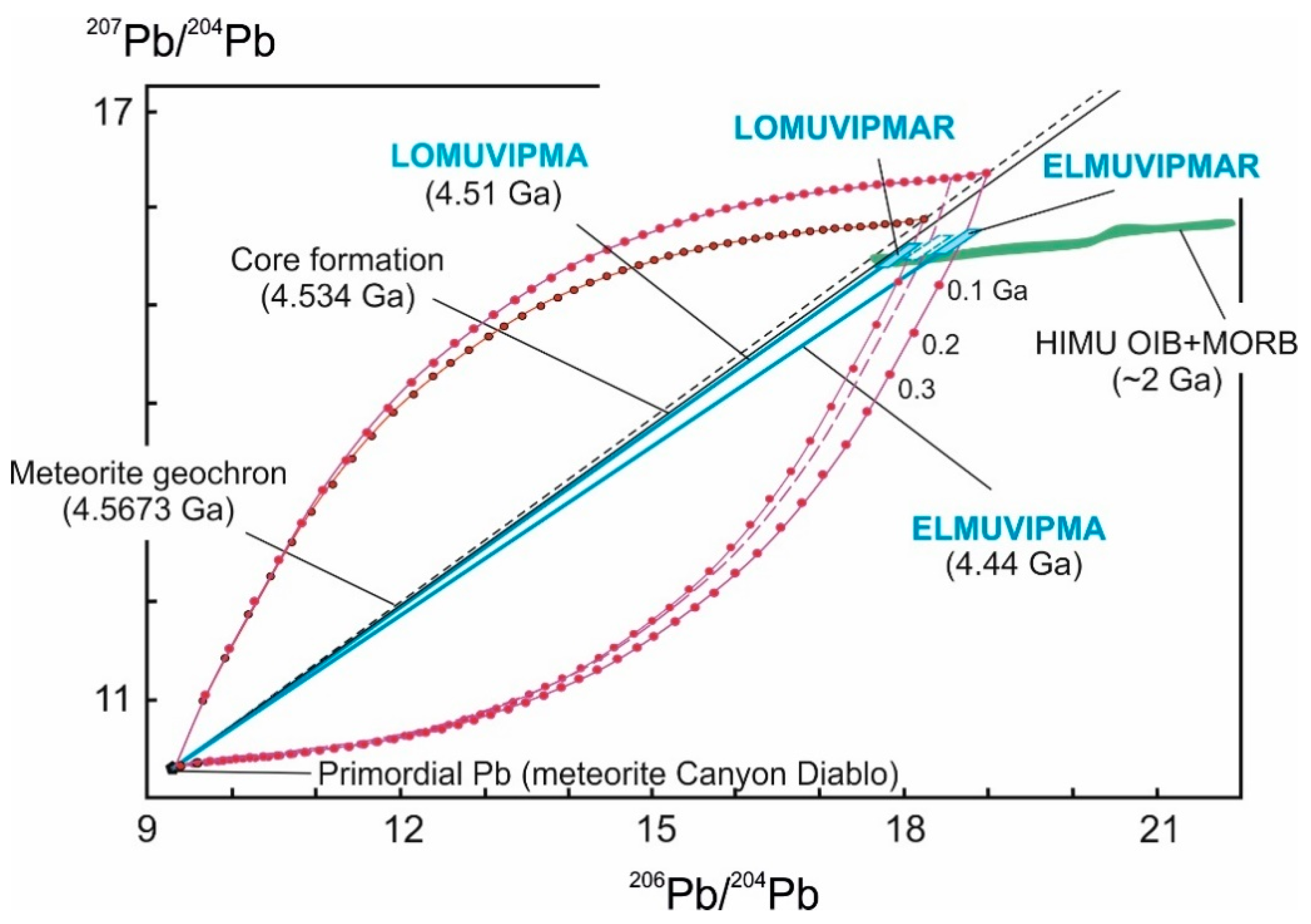
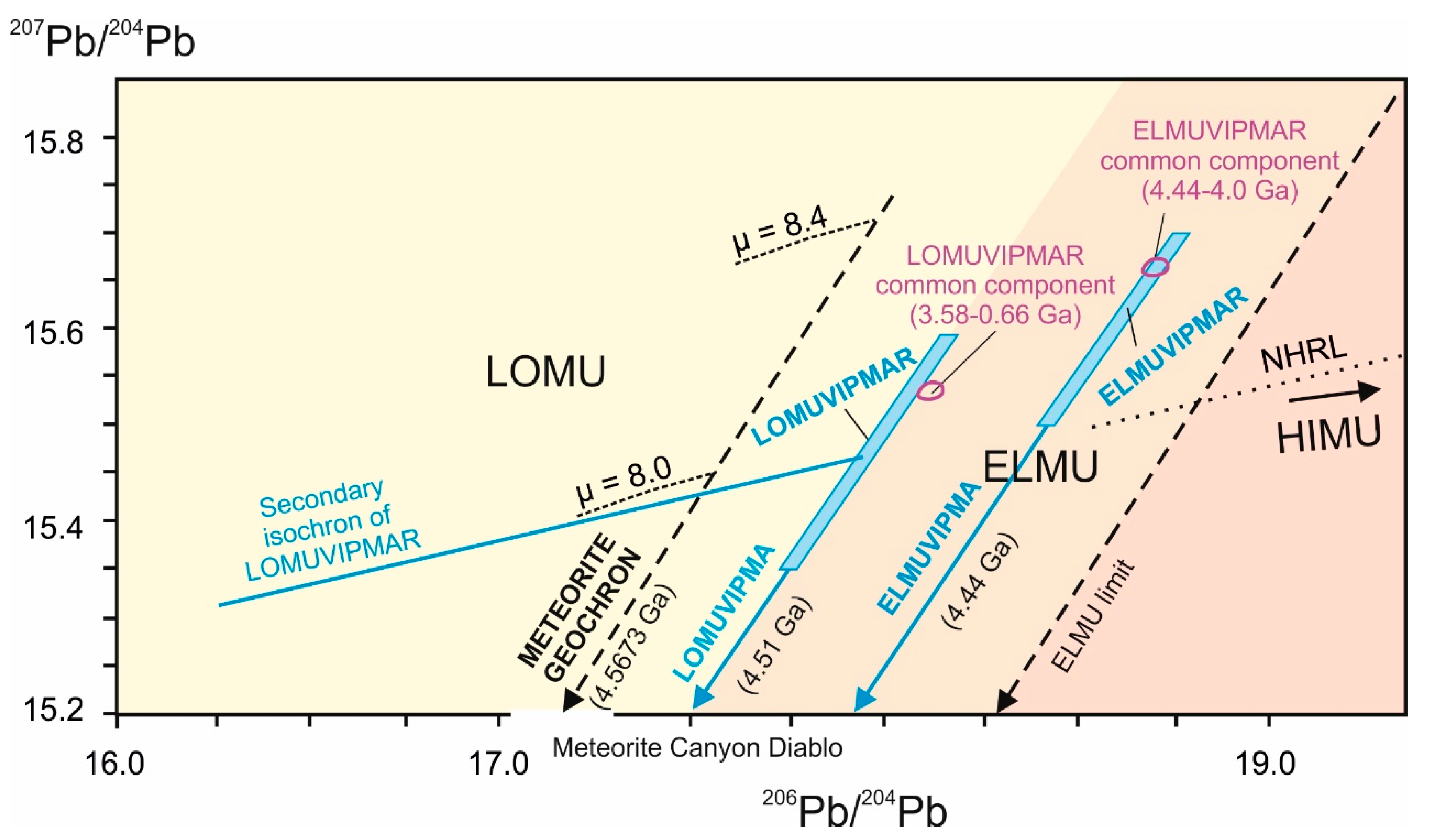
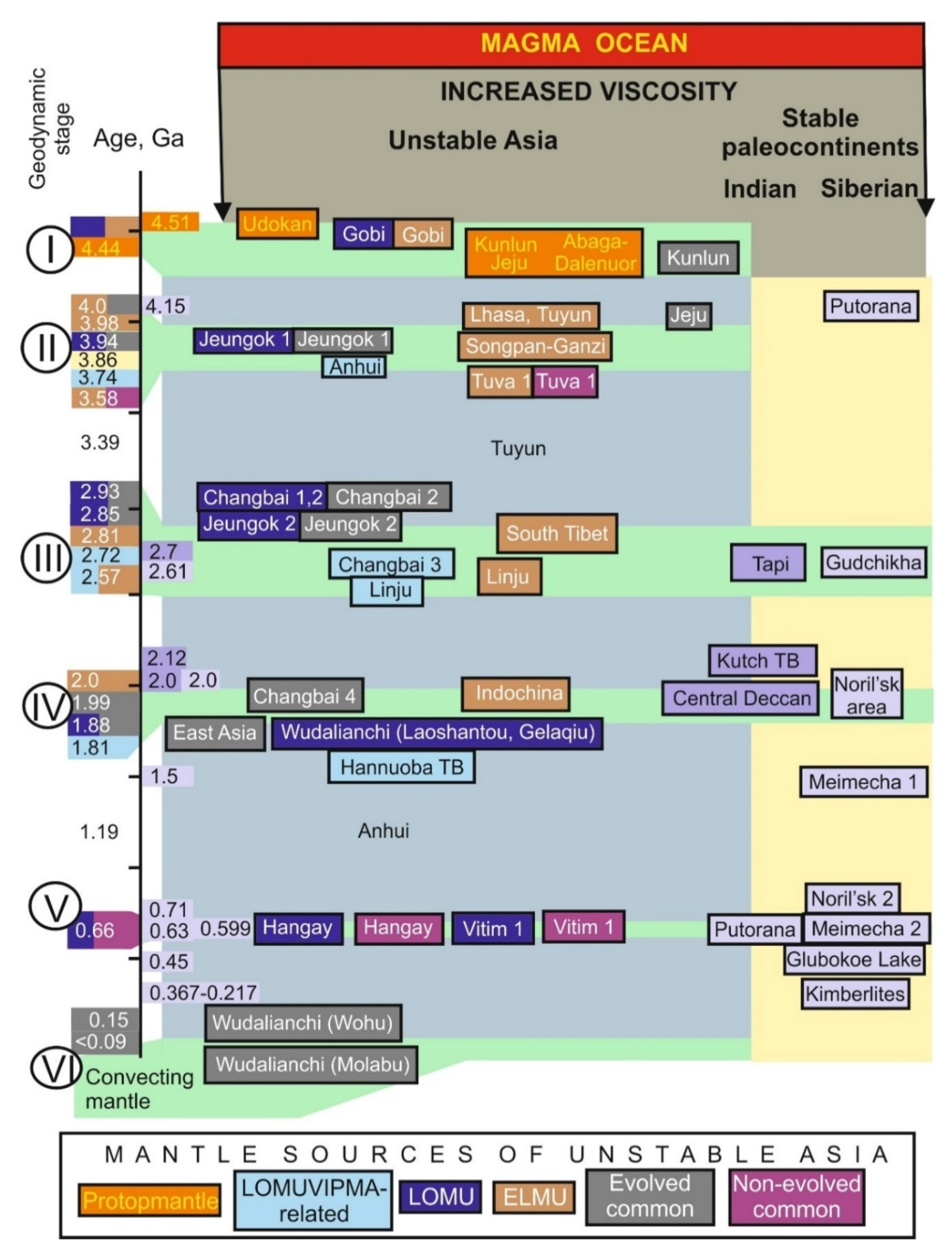
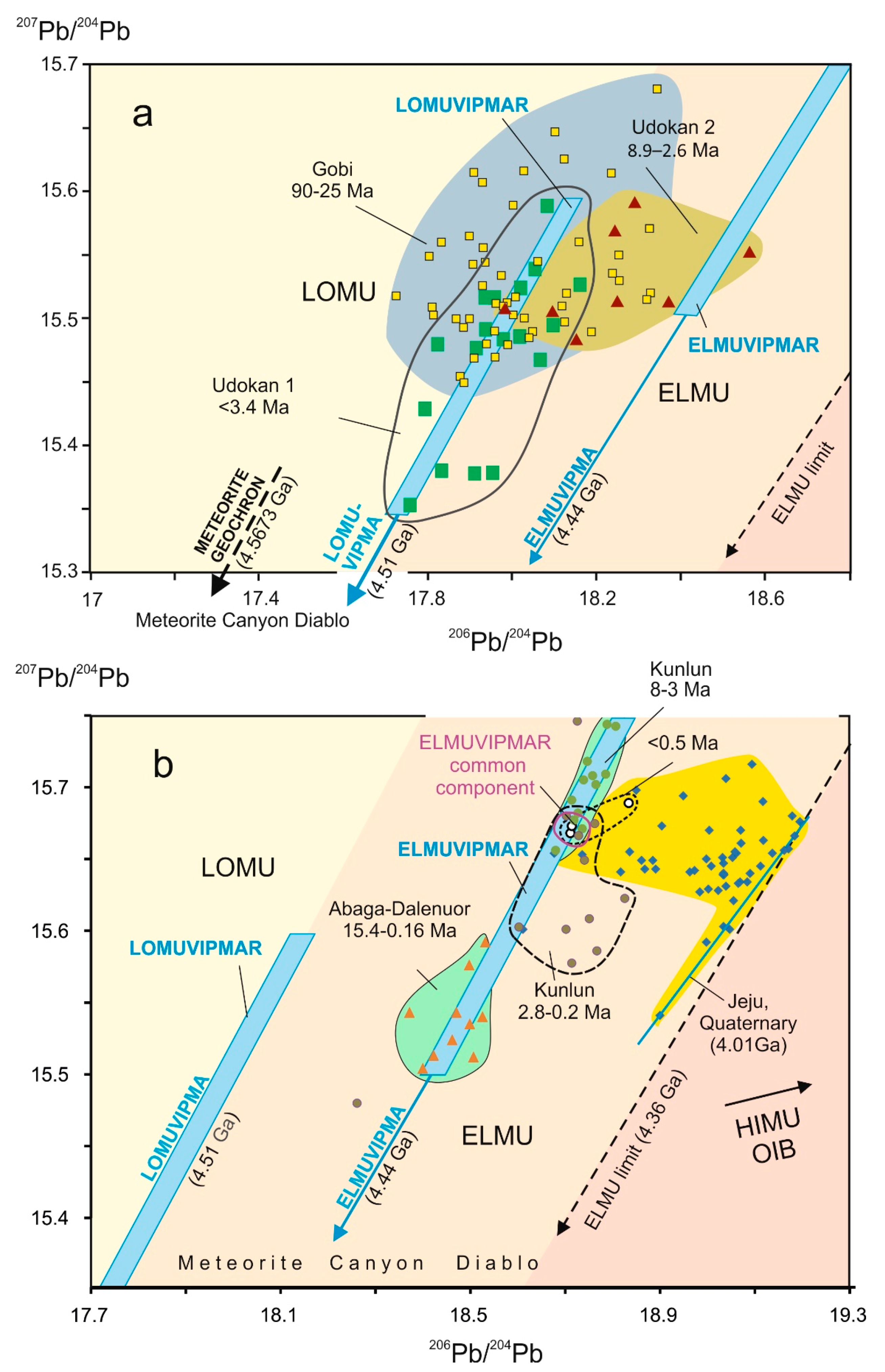
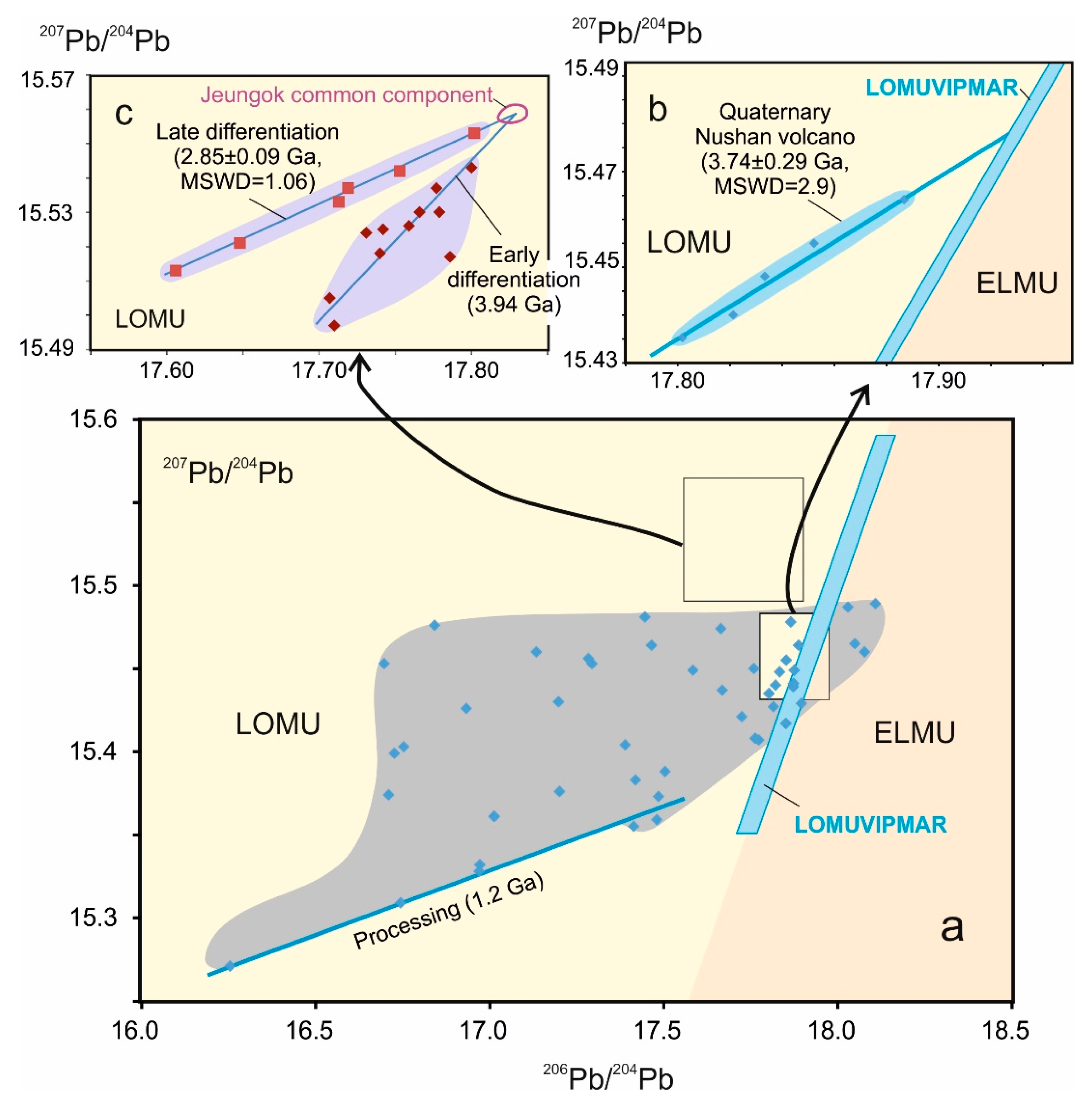
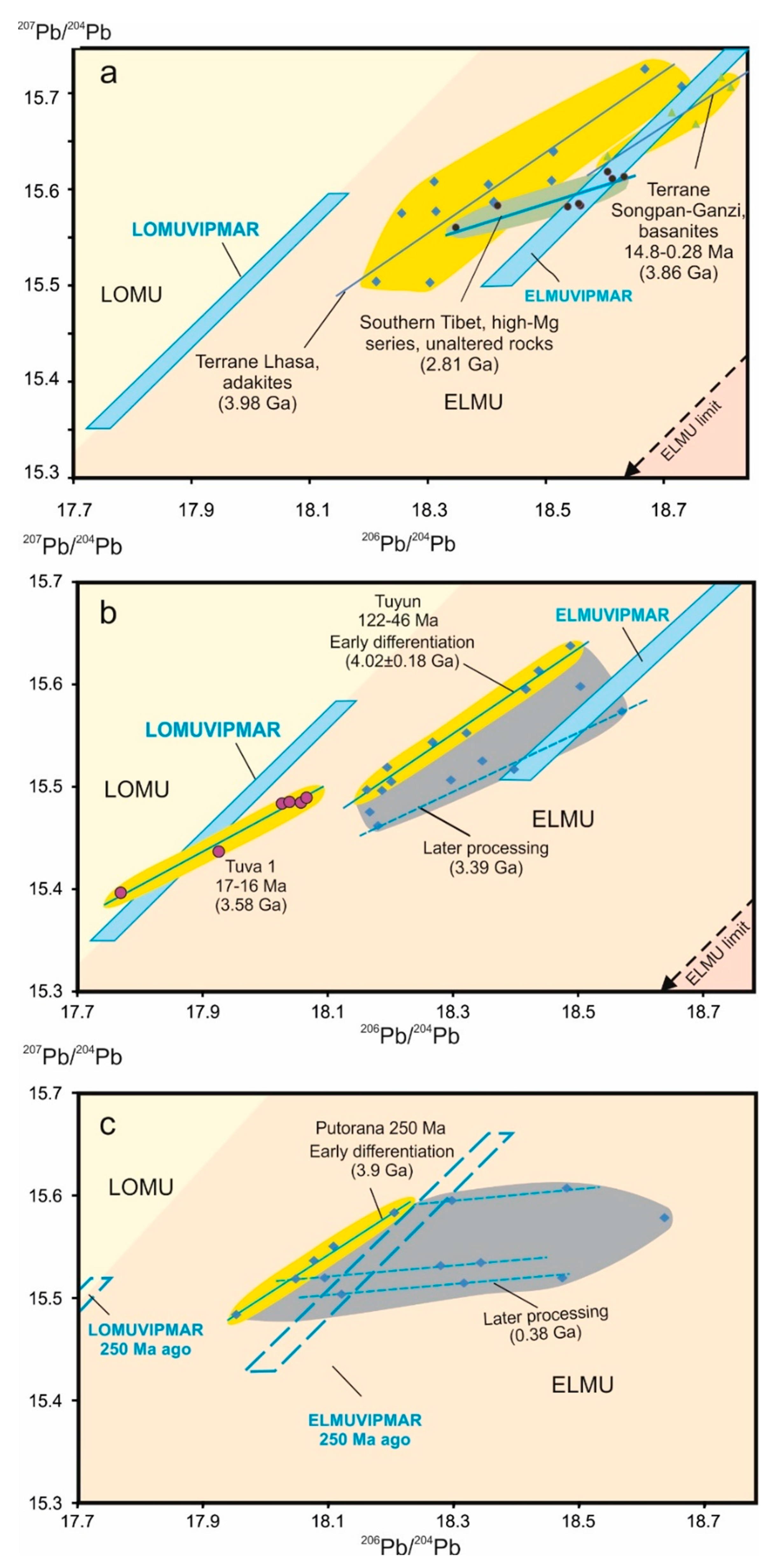
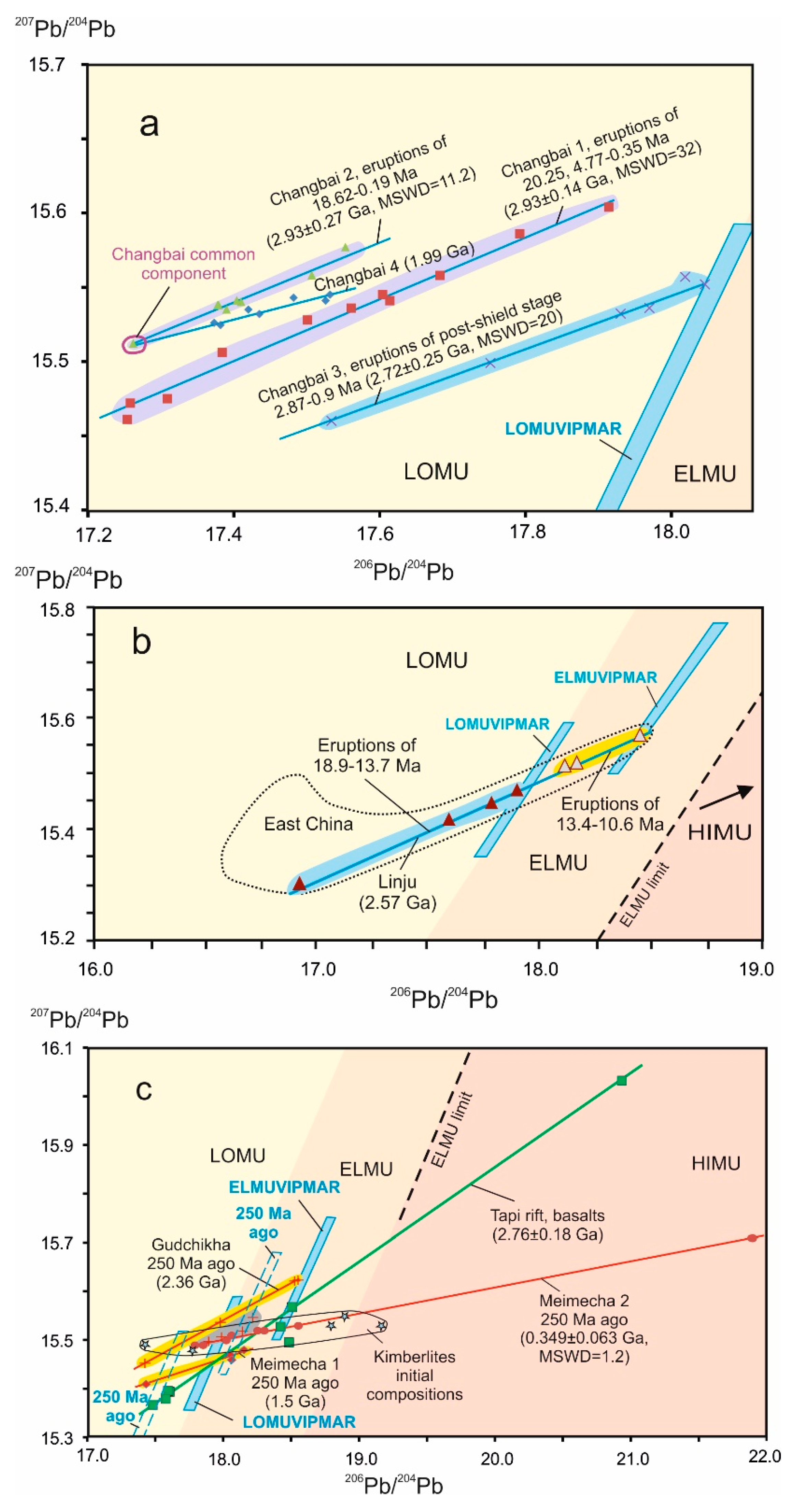
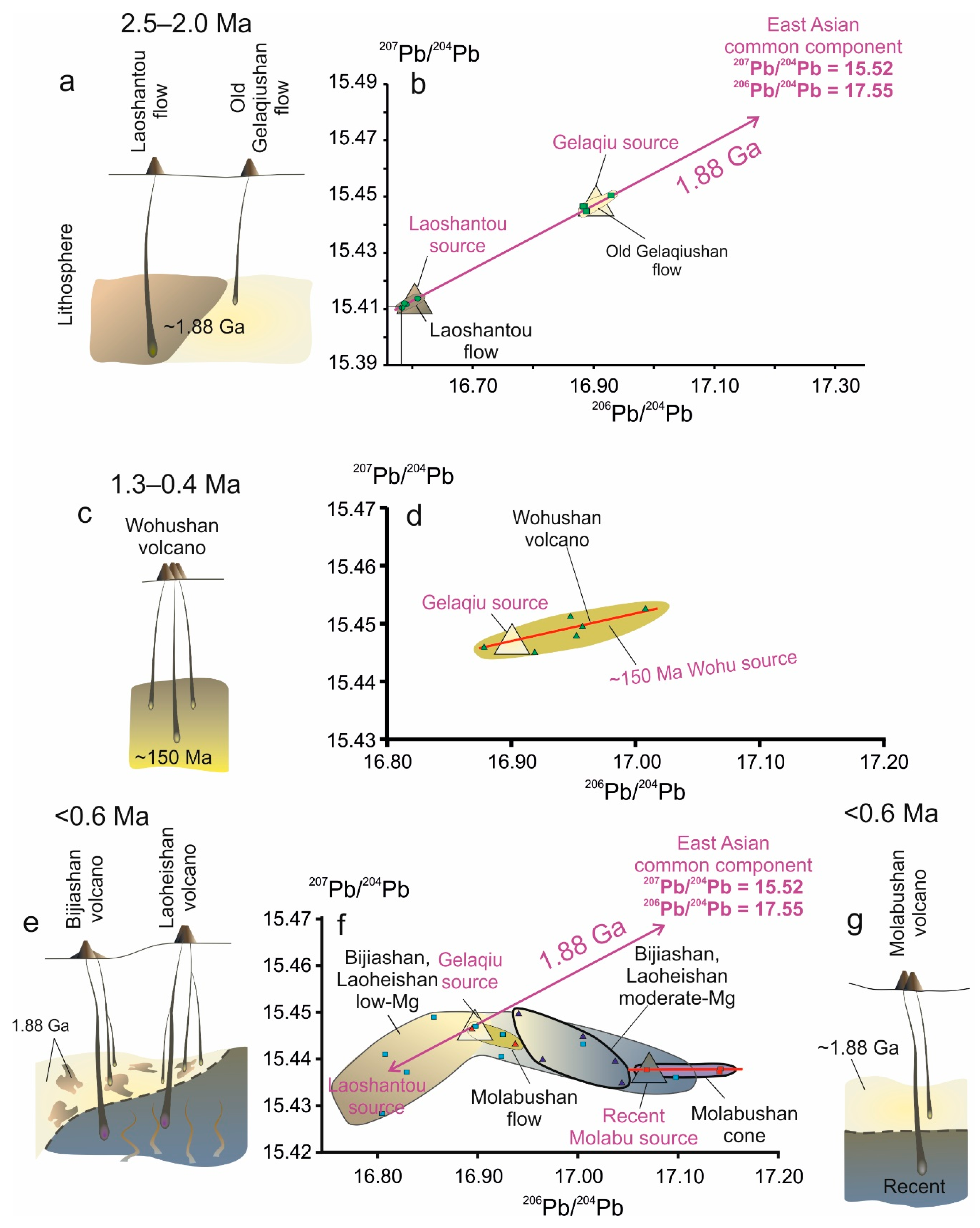
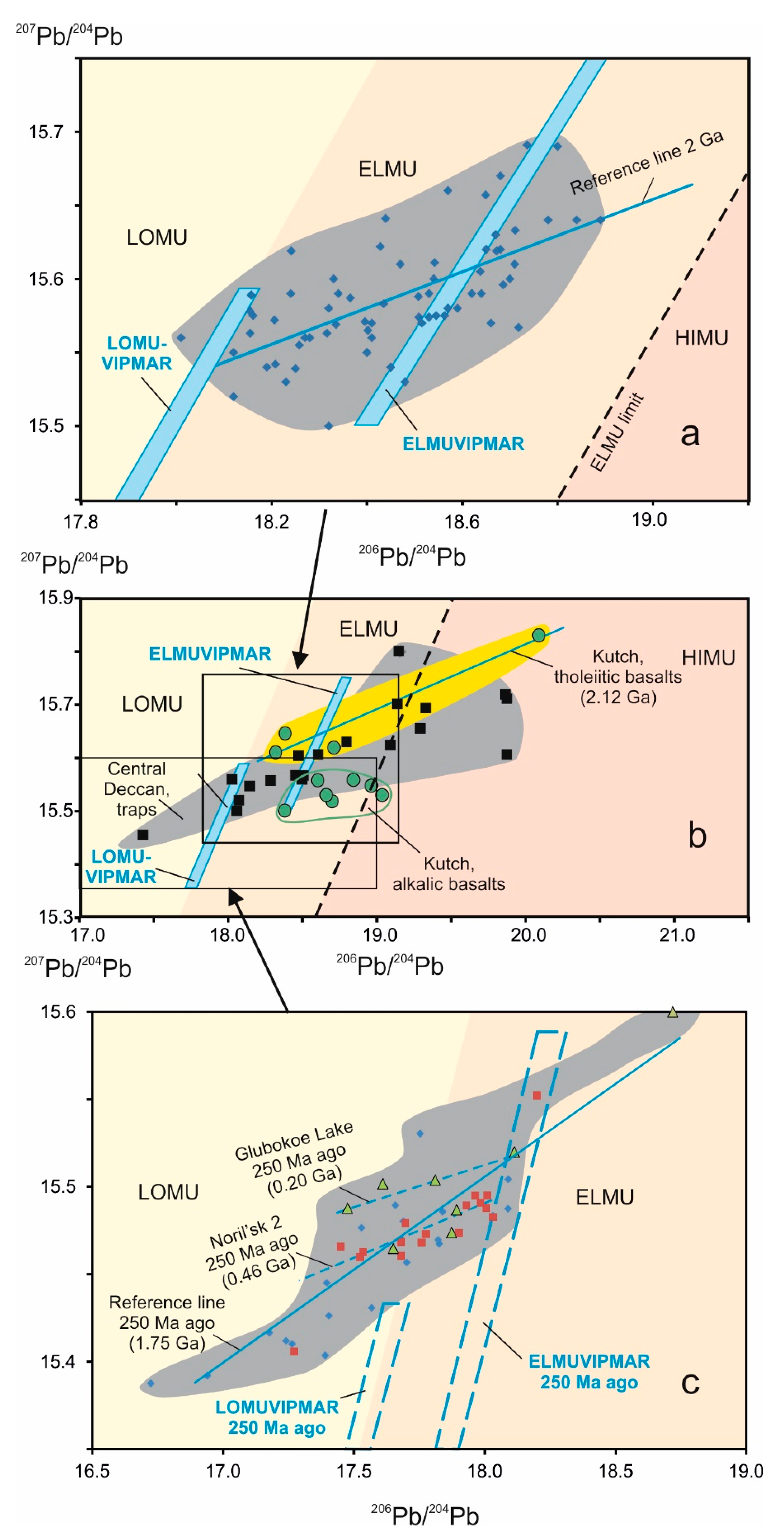
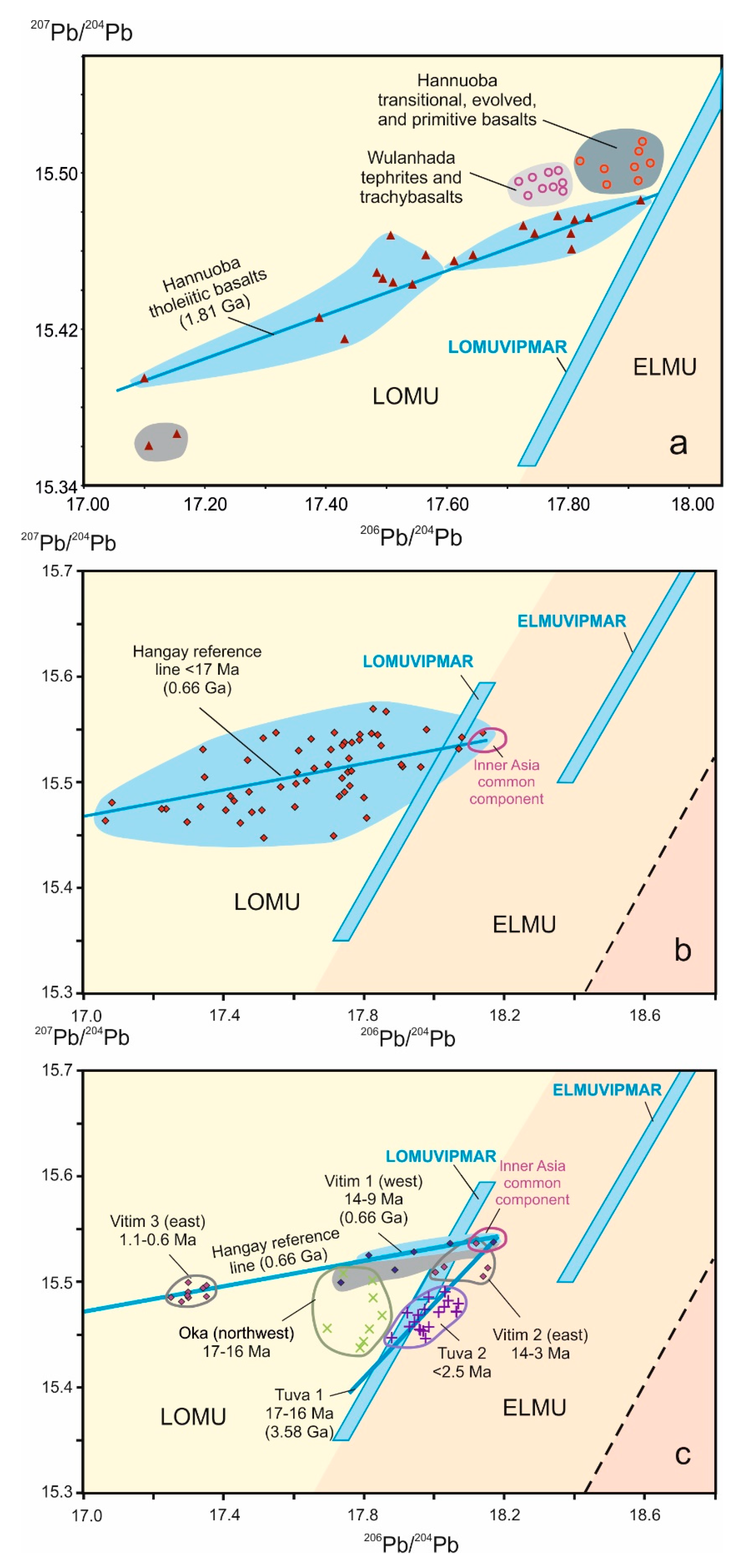
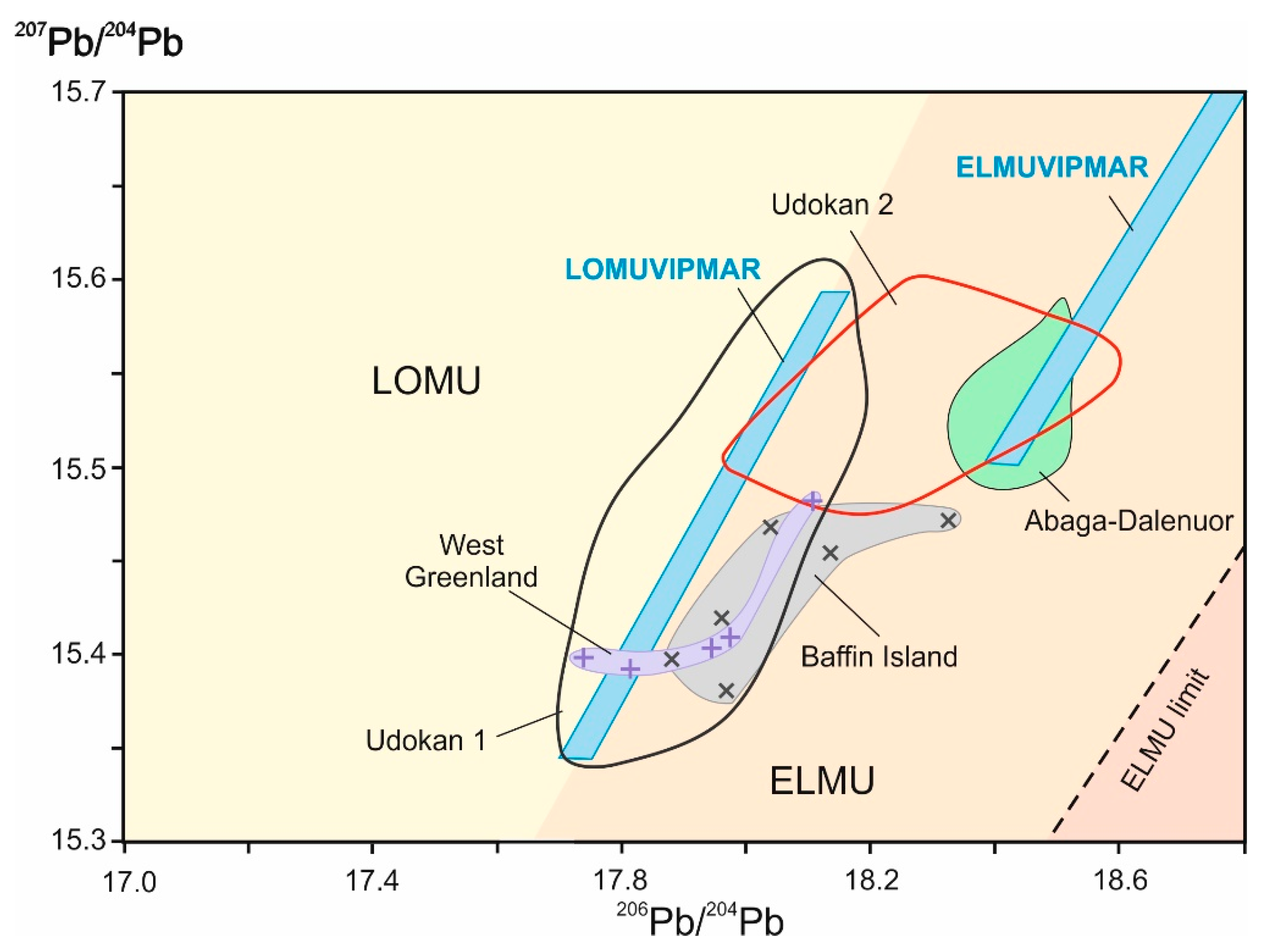

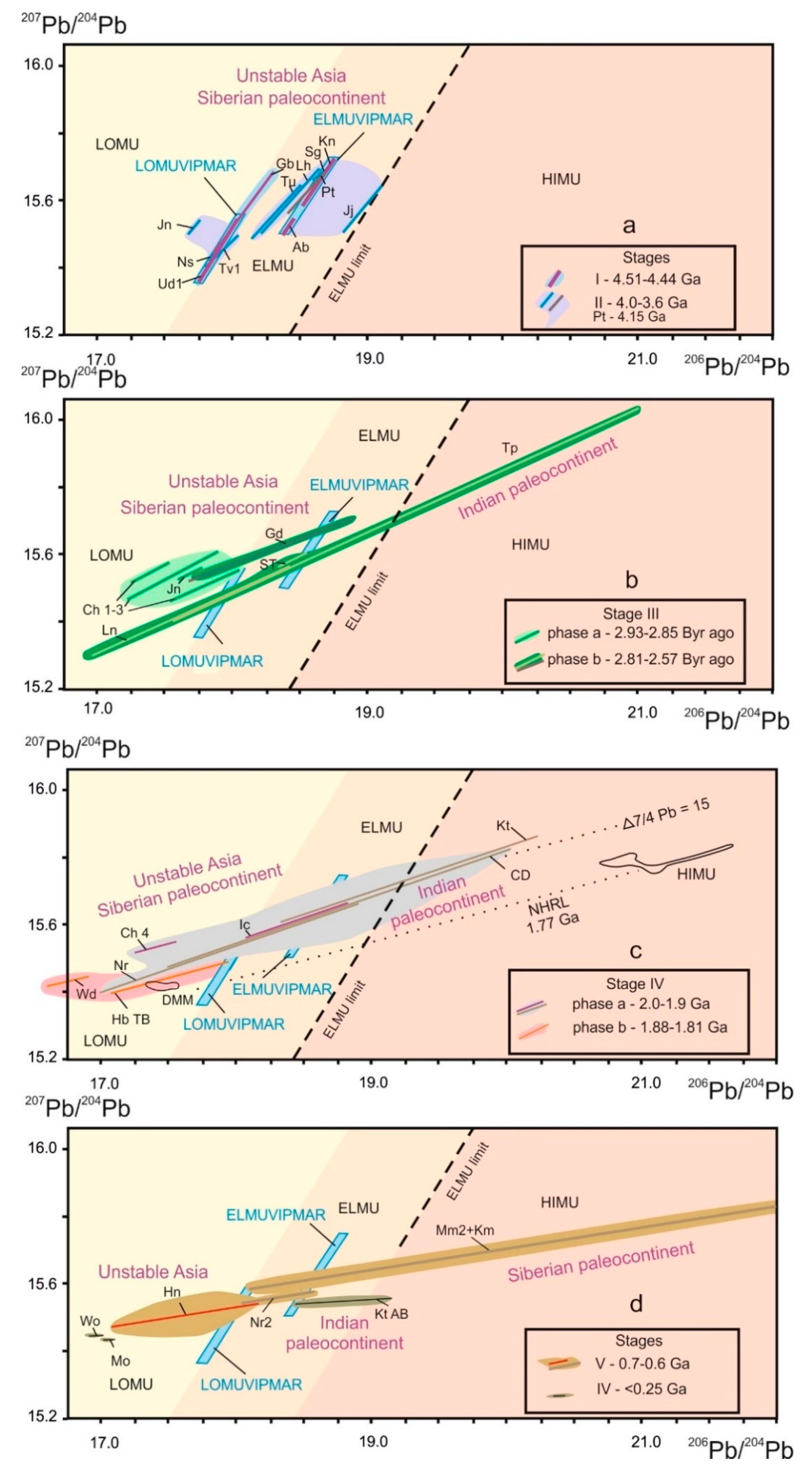
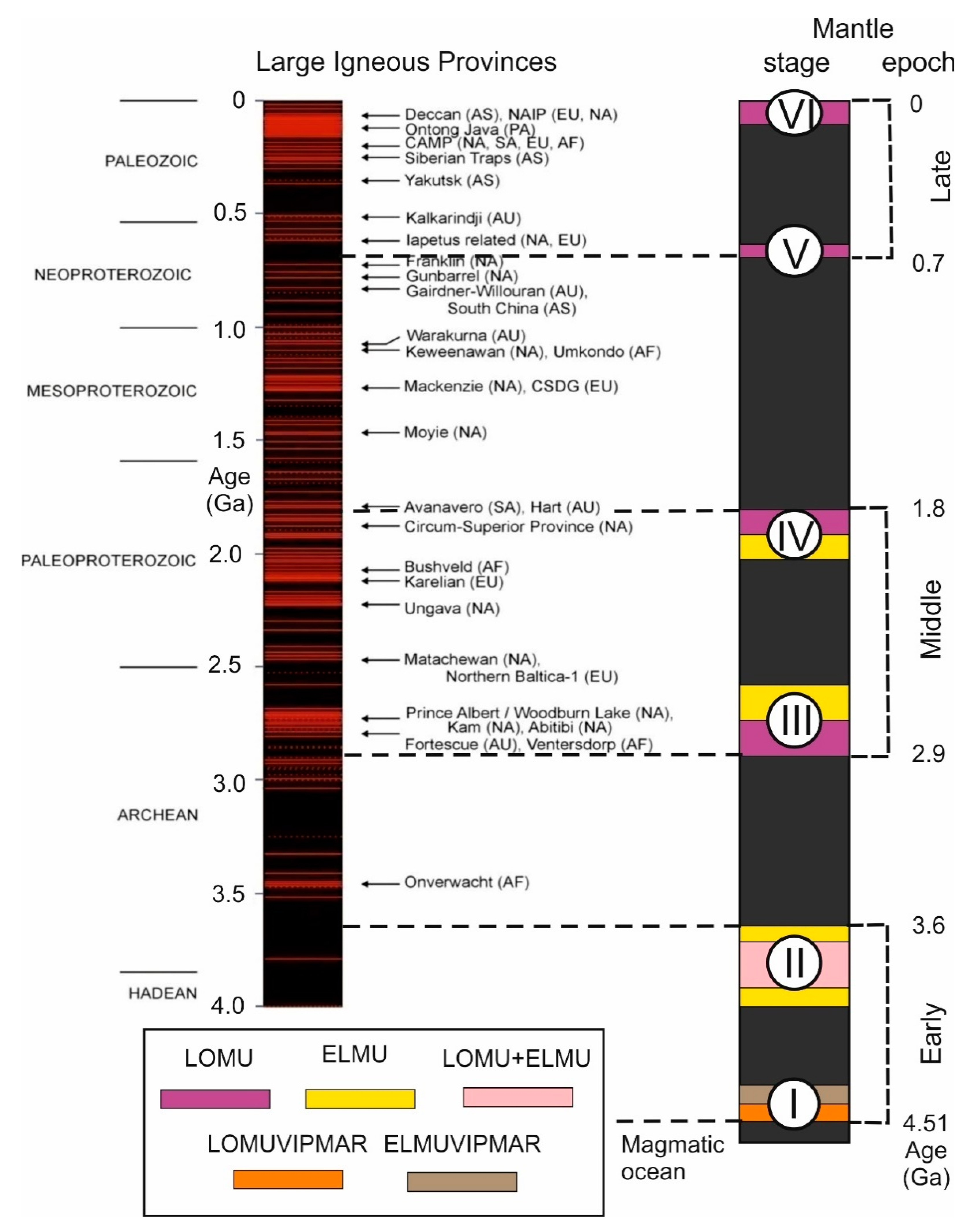
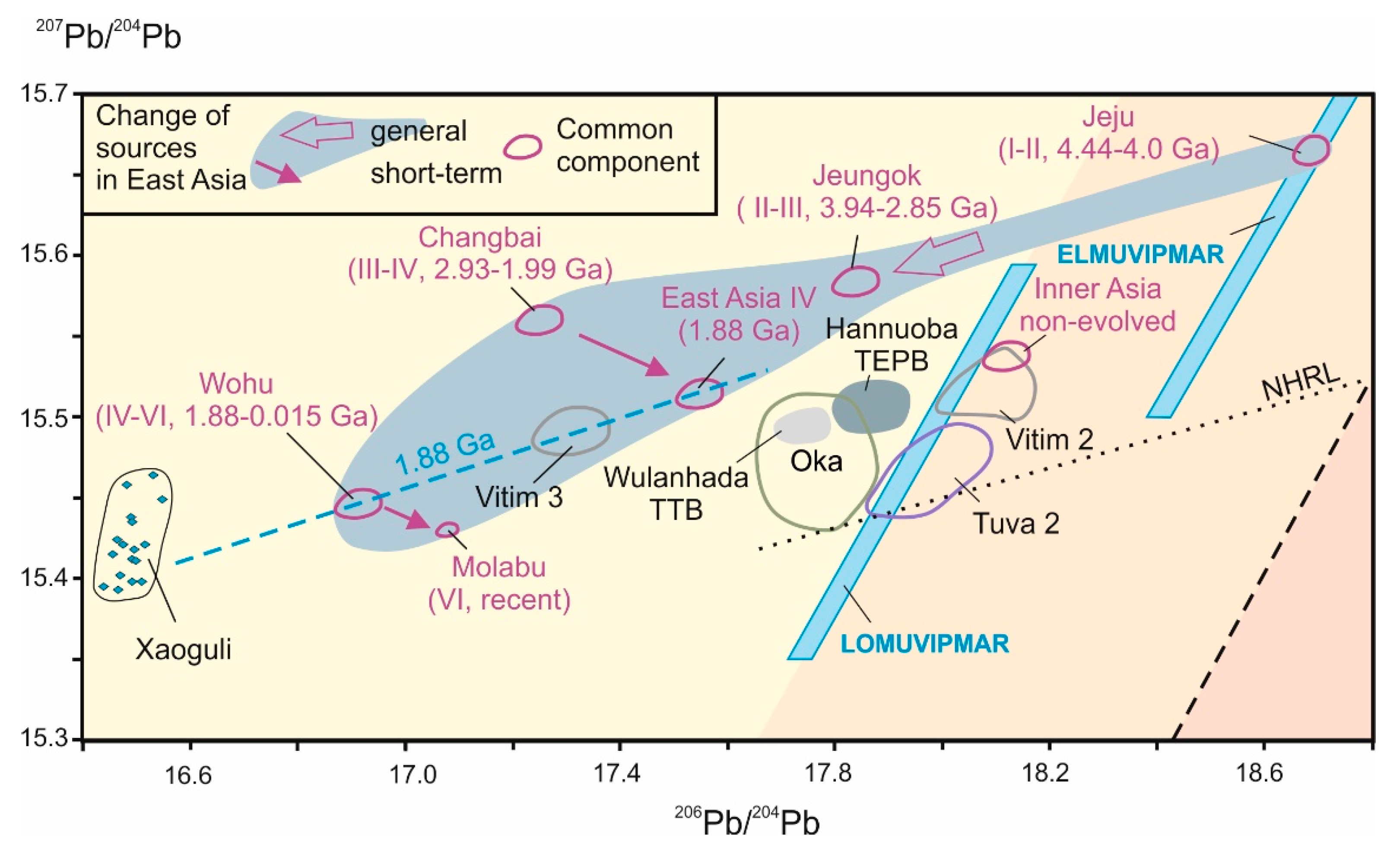
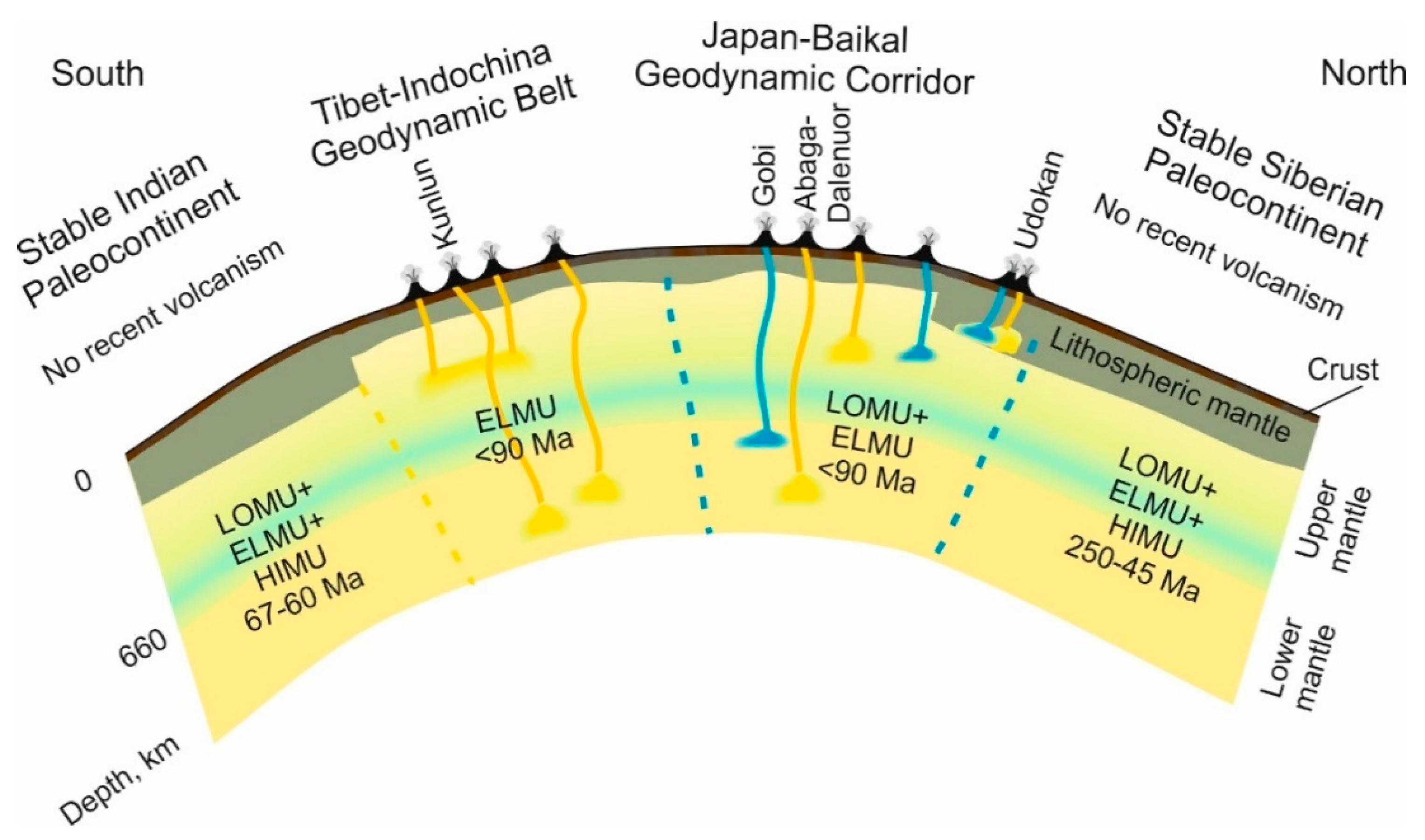
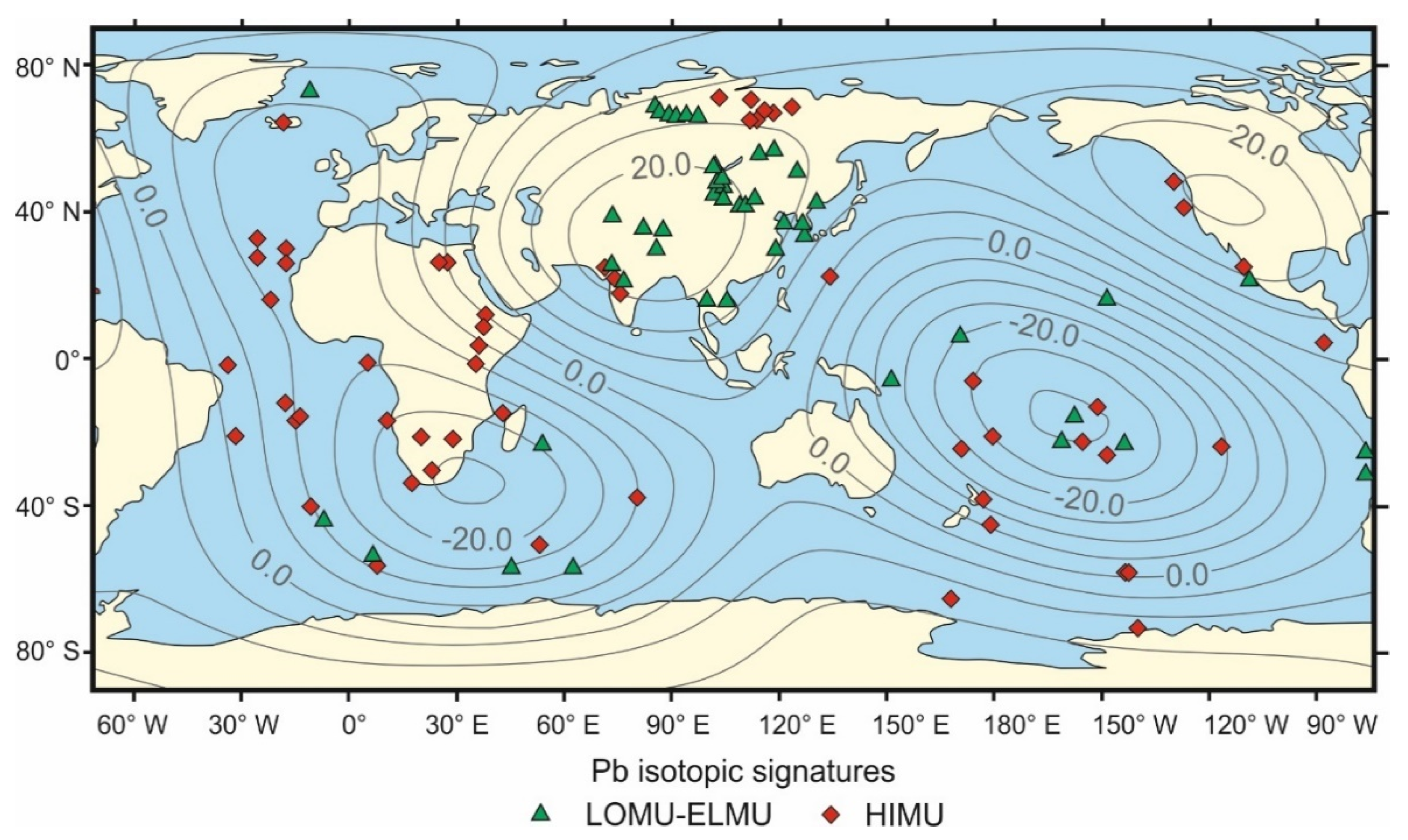
© 2020 by the authors. Licensee MDPI, Basel, Switzerland. This article is an open access article distributed under the terms and conditions of the Creative Commons Attribution (CC BY) license (http://creativecommons.org/licenses/by/4.0/).
Share and Cite
Rasskazov, S.; Chuvashova, I.; Yasnygina, T.; Saranina, E. Mantle Evolution of Asia Inferred from Pb Isotopic Signatures of Sources for Late Phanerozoic Volcanic Rocks. Minerals 2020, 10, 739. https://doi.org/10.3390/min10090739
Rasskazov S, Chuvashova I, Yasnygina T, Saranina E. Mantle Evolution of Asia Inferred from Pb Isotopic Signatures of Sources for Late Phanerozoic Volcanic Rocks. Minerals. 2020; 10(9):739. https://doi.org/10.3390/min10090739
Chicago/Turabian StyleRasskazov, Sergei, Irina Chuvashova, Tatyana Yasnygina, and Elena Saranina. 2020. "Mantle Evolution of Asia Inferred from Pb Isotopic Signatures of Sources for Late Phanerozoic Volcanic Rocks" Minerals 10, no. 9: 739. https://doi.org/10.3390/min10090739
APA StyleRasskazov, S., Chuvashova, I., Yasnygina, T., & Saranina, E. (2020). Mantle Evolution of Asia Inferred from Pb Isotopic Signatures of Sources for Late Phanerozoic Volcanic Rocks. Minerals, 10(9), 739. https://doi.org/10.3390/min10090739




